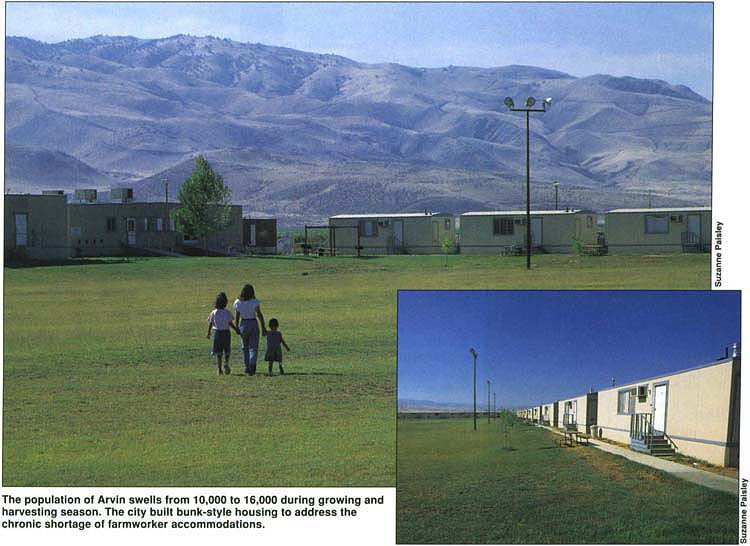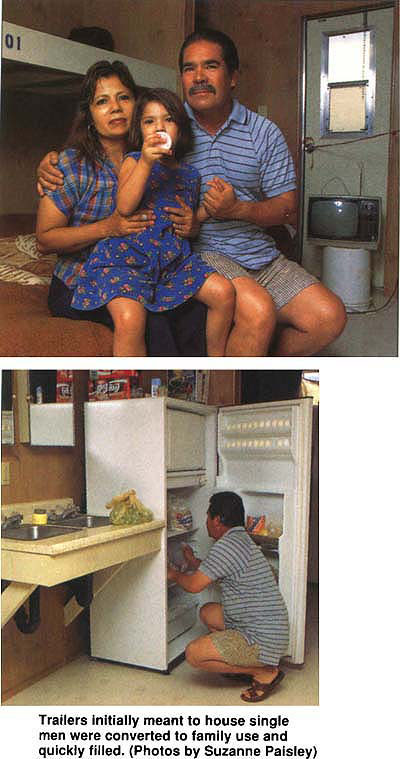All Issues
Farmworker housing in crisis: How rural communities can learn from the Arvin experience
Publication Information
California Agriculture 48(7):18-22.
Published December 01, 1994
PDF | Citation | Permissions
Abstract
A greater percentage of seasonal agricultural workers and their families live in California on a year-round basis than ever before. Rural communities are facing serious housing shortages; they must address farmworker needs ranging from short-term migrant facilities to permanent family residences. Arvin, California, pioneered an effort to reduce the farmworker housing shortage by supporting the development of an innovative housing environment for 300 men. This experience, while not totally satisfactory, suggests guidelines for other rural communities to utilize as they look for ways to address their own local housing needs.
Full text
The Bracero Program of the 1960s allowed Mexican farm laborers to be brought legally into California for short periods of time. Since the end of the program in 1965, rural communities have faced increasingly serious and complex farmworker housing shortages as a greater number of farmworkers and their families have opted to obtain legal residence status and live in California instead of migrating from Mexico on a seasonal basis. U.S. Labor Department statistics confirm that seasonal workers now perform more than 80% of all California farm work. The number of farm employees in the state ranges from more than 500,000 workers at peak season in September to a reported low of 253,000 in February. Of this number it is estimated that 54% of seasonal workers and their families spend the entire year in the United States, while another 30% are essentially permanent residents, spending less than 4 months each year out of state. Seventy-eight percent of these workers said they would prefer not to travel beyond normal commuting distances to work, but many do so for short periods as required to earn a living wage. Thus, a demand for both affordable permanent housing and short-term housing for seasonal labor persists in most rural areas.
The growing year-round presence of seasonal agricultural workers in rural communities has led to severe housing shortages and documented cases of overcrowding, rent gouging, and families or single men living in unsafe and unhealthy circumstances, such as sheds, backyards, cars, or outdoors throughout California. Newspaper reports of deplorable housing conditions often cast responsibility for these circumstances onto growers or rural communities, without discussing the statewide scope, magnitude, and complexity of the housing problems.
Rural communities face several obstacles in their efforts to address the seasonal farmworker housing crisis. Federal and state support for low-income rural housing has declined significantly in the last 15 years. In many areas suburban expansion into agricultural regions has raised land values and reduced the availability of land for low-income housing. California growers increasingly rely on farm labor contractors to supply seasonal workers, and have reduced the number of grower-operated seasonal labor housing units. The California Department of Housing and Community Development reports that registered employee housing sites declined from a high of over 5,000 in 1968 to just over 1,000 in 1994. Worsening economic and political conditions in Mexico and Central America have led to an increase in illegal immigration, further compounding rural housing problems. Solutions to rural housing shortages require careful assessment of farmworker housing needs in specific regions of the state, innovative and cost-effective approaches to housing design, and effective partnerships among communities, government funding agencies, and nonprofit housing providers to overcome these challenges.
The population of Arvin swells from 10,000 to 16,000 during growing and harvesting season. The city built bunk-style housing to address the chronic shortage of farmworker accommodations.
Arvin, a small agricultural community located in Kern County near Bakersfield, California, embarked on a housing project to reduce serious seasonal housing shortages in its area. Examination of Arvin's experiences in the development and operation of an innovative housing approach offers significant information and guidelines for other communities that may be contemplating housing programs in their own areas.
Arvin's farmworker housing project
Normally, Arvin is a community of around 10,000 people. But its population swells by 4,000 to 6,000 individuals during peak growing and harvest seasons. Concerned that affordable, decent housing be available for its short-term residents, the community agreed to sponsor construction of a 300-man bunk housing environment within town limits. A local developer proposed construction of bunk-type trailer dwellings for male seasonal employees to reduce the local housing need and provide an innovative, cost-effective alternative. The developer emphasized the importance of its cooperative private-public venture as a first step in solving the state's farmworker housing crisis, and envisioned a system of such housing centers throughout the state.
Some local growers and labor contractors were asked to participate in the financing and to rent or purchase blocks of beds for their employees, but all refused, declaring they could house workers in grower-owned housing or in low-fee hotels in Bakersfield for less. Arvin also invited the Housing Authority of Kern County to become involved, but the authority declined, predicting that the project was not financially viable.
Trailers initially meant to house single men were converted to family use and quickly filled. (Photos by Suzanne Paisley)
Nonetheless, Arvin decided to proceed, funded by private investors and city loan guarantees. The $3-million village opened for occupancy in October 1992. The fenced site included 50 trailers housing six men each, a recreation building, and a combination grocery, laundry and administrative building. Bunk trailers surrounded a large soccer field at the center of the site; two tennis courts were constructed; and parking was located outside a controlled entry gate. Each trailer was a complete living unit with six bunk beds, a small kitchen, shower, and toilet spaces; and each complied with the minimal standards of the Employee Housing Act for farm labor housing. The opening was heralded in the local press as an example of the private sector's capacity to creatively address the region's critical farmworker housing shortage.
However, the housing project did not perform as predicted. Despite the developer's market research, only 16 men rented bunks in the first 7 months of operation. Disturbed by this outcome, as well as other aspects of the project management, the City of Arvin took over operation in April 1993. A former city treasurer was asked to manage the project and its finances. City officials obtained permission from the California Department of Housing and Community Development to convert one bunk in each of the trailers to a fold-out double bed for couples. Renamed Arvin Village, the development was reopened for family housing. Within 3 weeks all dwellings were rented and there was a waiting list of more than 80 families.
The grocery store was stocked with items requested by residents, tennis courts were converted to basketball courts, picnic areas were constructed around the soccer field, and the recreation building was stocked with activities for adults and children. Arvin Village began to function smoothly and long-range plans were implemented for site maintenance, improvements, and payment on the project debt.
However, Arvin Village's recovery experienced a serious setback during the winter of 1993–94, when prolonged rainfall and freezing weather caused roofs to leak, walls to warp and floors to buckle. The freezing weather also damaged crops and caused widespread unemployment. Workers unable to pay the monthly rent “moved out in droves,” according to City Manager Thomas Payne. “Everything that could go wrong did go wrong,” he recounted. By April, occupancy had dropped to just six families and 15 men. With the end of poor weather, the dwellings were repaired and farm employment was restored. Families returned to the project and today it is running at full capacity. Yet the project still faces persistent long-range problems: high maintenance costs and rents that are unaffordable for unemployed workers.
Lessons from Arvin
What can be learned from Arvin's housing project that can be of use to other rural communities contemplating farmworker housing solutions? Despite disappointing and costly setbacks, Arvin remains generally supportive of its effort to create affordable dwellings for its seasonal farmworker population. The community is currently exploring ways to generate more subsidized financing and to develop housing units more appropriate for families. The original project investors have also remained firmly behind the project, despite the setbacks. None has asked for repayment of their original investment; several investors told the city manager they feel a “moral responsibility” to Arvin Village.
An analysis of the steps this small community took to address its farmworker housing shortage can offer important information for other rural areas as they consider projects to meet their own housing needs. Seven significant guidelines are suggested by examination of Arvin Village's development.
Assess needs of the area
Arvin's farmworker housing shortage was well documented in reports such as Kern County's Comprehensive Housing Affordability Strategy (CHAS), a recent Housing Market Survey prepared for the Housing Authority of the County of Kern (HACK), and employment statistics from the California Employment Development Department (EDD). According to 1990 EDD statistics, Kern County employed about 23,000 seasonal workers during its peak season. While the EDD statistics did not report the number of these seasonal workers who were county residents at that time, the CHAS estimated that about 9,200 were resident seasonal workers and almost 14,000 were migrant laborers from other areas. The 1993 CHAS targeted the Arvin area as desperately needing affordable low-income housing for both resident and migrant farmworker families.
The county housing authority manages 280 units of seasonal migrant farmworker housing for the California Office of Migrant Services. These units, which are open 6 months of the year, are always in high demand. In addition, Kern County has 33 registered bunkhouse facilities housing 837 employees, predominantly male, on a seasonal basis. Privately rented dwellings, many in substandard condition, can also be found in Arvin. A survey prepared for HACK in 1991 indicated that Arvin had “no vacancy” in rentals.
Arvin Village's success as a family housing unit demonstrates the need for affordable family housing. The plan to house 300 men at one location may have contributed to the original project's failure. Questioned by local labor contractors, male migrant workers expressed concern about potential fights, alcohol abuse, and theft in an all-male environment. Those concerns, coupled with the $180-per-man monthly bunk rental, may have discouraged many renters.
Match housing types to needs
Previous research based on interviews with farmworkers indicates that each agricultural region of the state has specific and different housing needs based on three factors: the length of stay of seasonal and migrant workers, the presence or absence of complete families, and farmworkers' ability to afford housing. According to the California Institute for Rural Studies, the greatest percentage of year-round resident farmworker families live in the farming regions of the Central Valley. California's north central and south coast regions have greater percentages of migrant male workers traveling without families. Knowing the term of residence and the presence or absence of complete families is essential to planning housing types.
Bunk trailers in manageable numbers can work for males traveling alone but are unsuitable for families, especially for extended periods of time. At Arvin Village, six individuals, including parents and children ranging from infants to teenagers, may be crowded into a 392-square-foot space, limiting activities to little beyond sleeping and eating. Privacy is minimal. Storage for clothing and personal belongings is inadequate and the absence of outdoor clotheslines necessitates hanging laundry on porch railings or using costly clothes dryers. The potential for energy savings through cross ventilation and good thermal insulation was ignored in the original design. The regimented placement and uniform color treatment of the dwellings created the somewhat dehumanizing appearance of barracks instead of a pleasant residential community.
Freezing weather and unemployment took their toll on the housing complex where “everything that could go wrong did,” according to one city official. (Photo by Suzanne Paisley)
Housing alternatives and innovative, cost-saving methods must be explored. There is a need for a variety of living situations including year-round enclaves of small family dwellings with common recreation and laundry facilities; short-term, male-focused, bunk-type environments in the form of hostels; roadside rests with toilet, laundry facilities and farmworker campgrounds; efficiency units for men; and multifamily rental units. Comprehensive assessment of the farmworker population can result in responsible projects tailored to local demands.
Affordability is a significant factor
Rent for Arvin's family dwellings is $450 per month, including utilities. This is high when compared to rents of between $135 and $210 per month charged by California's Office of Migrant Services' (OMS) family centers for larger and more pleasant two- and three-bedroom dwellings. The OMS centers are affordable for families in part because the low rents are subsidized by state funds, although there have been efforts in recent years to raise rates. The National Agricultural Workers Survey reports the average annual income of seasonal workers is between $5,000 and $7,500. Using the standard government estimate of 30% of income for housing, rents for individuals should average between $125 and $185 per month for singles, and between $250 and $375 per month for working couples.
Clearly, Arvin needs some type of external rent subsidy for residents if it is to operate year-round and repay the project debt. Farmworkers are willing to contribute to the rent, but their ability to pay is limited by their incomes. Innovative and cost-effective housing designs are key factors in addressing the issue of affordability.
Supervise specifications and construction closely
Arvin failed to employ professional consultants responsible to the community for knowledgeable assessment of materials and construction methods and for inspection of the dwellings as they were built. The absence of expert advice resulted in what many believed to be poorly constructed dwellings requiring costly maintenance.
Consult with local growers
Arvin sought participation of some growers, but failed to create a working partnership. Yet growers, as members of the rural community, can lend expertise about the numbers of seasonal workers, their needs, periods of employment, and most importantly, access to land suitable for farmworker housing. Arvin was able to purchase a large site within town limits. But other communities may not have available properties and will need to draw upon land parcels owned by growers. Arvin's site permitted housing for 50 families in one location. Smaller housing enclaves with reduced concentrations of farmworkers may be an alternative for regions concerned about the overall impact of farmworker housing projects on local traffic patterns, and integration and acceptance of the housing into the local fabric.
Solicit suggestions from workers
Farmworkers can offer valuable information about appropriate housing types, contribute to project costs through payment of reasonable rents, and be responsible for effective project management through participation in tenant committees. At many housing forums farmworkers have expressed their desire for clean, safe, and affordable housing, and they harbor few illusions about the housing amenities they can afford. Until the city assumed management of Arvin Village, suggestions from local seasonal workers were not solicited. Ongoing consultation with families on products for the store, planned recreational activities, and grievances has produced a sense of “ownership” among residents which in turn has promoted tenant responsibility for community behavior and maintenance.
Build effective partnerships with government and nonprofit entities
Arvin joined forces with a development group in the belief that its housing concept was innovative and cost-effective. The town proceeded despite a warning by the Kern County Housing Authority that the project was financially problematic. Arvin also failed to avail itself of existing state and federal funding sources, or consultation with experienced nonprofit housing and human service providers.
While state and federal funding for farmworker housing has been reduced in the last 15 years, nonprofit housing groups and county housing authorities have developed many rental units and home ownership opportunities for low-income farmworker families. These housing developers and agencies can offer significant assistance with needs assessment and design, financing and construction, and longterm management and maintenance systems for farmworker housing.
Nonprofit housing developers tend to focus on self-help housing for more successful farmworker families, and multifamily rental housing for lower-income families. In recent years, however, they have begun to consider innovative short-term rentals for migrant male workers and families in recognition of the variety of housing needs in the state.
Although the community suffered considerable setbacks, Arvin's experience can provide a valuable lesson for other communities considering farmworker housing. (Photo by Suzanne Paisley)
Besides providing affordable shelter, farmworker housing projects offer opportunities to educate residents and their children about work and language skills, legal and health issues, and cultural information that will help them function successfully in California. Nonprofit housing groups often work with other service providers in child care, health, and education services to assist communities in tailoring programs to fit local needs and resources. Funding derived from comprehensive partnerships have produced successful farmworker housing projects throughout the state.
Conclusions
Looking back to a time when migrant workers came to California for seasonal work and then returned to homes in Mexico denies the present reality. Most seasonal farmworkers and their families live in California year-round and they desperately need decent, safe, and affordable housing if they are to obtain regular employment, education and job training, and make a sustained contribution to the state's agricultural economy and rural community development. Innovative and cost-effective housing solutions are essential to meet critical housing shortages and address the range of short- and long-term housing settings this population group can afford.
Leadership in solving the housing crisis can best come from rural communities such as Arvin, which routinely confront housing shortages and are most impacted by the inclusion of farmworker housing within their areas. While Arvin Village has a problematic history, its experience suggests that small rural communities can initiate farmworker housing projects with positive results. Arvin's most significant problems arose from a lack of expertise in housing development and a failure to organize a cooperative approach to the project. Despite the difficulties, 50 seasonal labor families now live in a decent setting, making productive contributions to the local economy.
Many other challenges face agricultural communities: rapid population growth, demographic shifts, suburban encroachment, aging or inadequate infrastructure, and the need to revitalize economic activities to balance or enhance agribusiness. Comprehensive planning that provides for the housing needs of seasonal agricultural workers can help communities make responsible decisions about their environment and the community's future. Effective partnerships among rural communities, local growers, farmworker residents, and experienced local, state, and federal housing and human service agencies are key to sound project planning and integration of farmworker housing with established local traditions and longterm goals. Guidelines suggested by Arvin's experience point to potential success for other rural communities willing to venture into farmworker housing developments.








